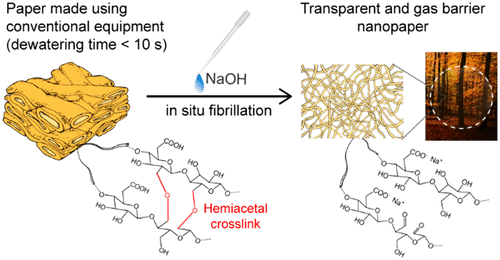当前位置:
X-MOL 学术
›
Biomacromolecules
›
论文详情
Our official English website, www.x-mol.net, welcomes your
feedback! (Note: you will need to create a separate account there.)
Self-Fibrillating Cellulose Fibers: Rapid In Situ Nanofibrillation to Prepare Strong, Transparent, and Gas Barrier Nanopapers.
Biomacromolecules ( IF 5.5 ) Pub Date : 2020-03-13 , DOI: 10.1021/acs.biomac.0c00040 Yunus Can Gorur 1 , Per A Larsson 1 , Lars Wågberg 1
Biomacromolecules ( IF 5.5 ) Pub Date : 2020-03-13 , DOI: 10.1021/acs.biomac.0c00040 Yunus Can Gorur 1 , Per A Larsson 1 , Lars Wågberg 1
Affiliation

|
Cellulose nanofibrils (CNFs) prepared from wood biomass are promising candidates to replace oil-based materials in, for example, packaging applications. However, CNFs’ affinity for water combined with their small size leads to very slow and energy-demanding processes for handling and removal of water. To a large extent, this is the major roadblock that prevents a feasible production of dry CNF-based materials on an industrial scale. In this work, self-fibrillating fibers (SFFs) from wood, where the fibrils can be liberated by external stimuli, were prepared via sequential TEMPO and periodate oxidation reactions. Papers made from these modified fibers using conventional laboratory papermaking methods were then in situ nanofibrillated via a modest pH increase. With a dewatering time of less than 10 s for a 3 g/L dispersion, SFFs represent a major improvement over conventional CNF nanopapers that take approximately 6 h to dewater. Moreover, 100 g/m2 nanopapers obtained through in situ fibrillation exhibited comparable, if not superior, properties to those reported for conventionally made CNF films. A tensile strength of 184 MPa, a Young’s modulus of 5.2 GPa, a strain at break of 4.6%, 90% optical transmittance, and an oxygen permeability of 0.7 cm3 μm m–2 d–1 kPa–1 at 50% RH were measured for SFF nanopapers. Furthermore, in situ nanofibrillation of the SFFs can also be achieved from already dried papers, facilitating numerous possibilities in terms of logistics and handling for an industrial scale-up and transportation of nanomaterials. Overall, stimuli-induced SFFs indeed enable a rapid production of strong, transparent, gas barrier nanopapers, which likely can be industrially scaled up and eventually compete with the oil-based plastics in the market for packaging materials.
中文翻译:

自纤化纤维素纤维:快速原位纳纤化,可制备结实,透明和阻气的纳米纸。
由木材生物质制得的纤维素纳米原纤维(CNF)在例如包装应用中有望替代油基材料。但是,CNF对水的亲和力以及体积小导致处理和除去水的过程非常缓慢且耗能。在很大程度上,这是阻碍在工业规模上可行地生产干燥的基于CNF的材料的主要障碍。在这项工作中,通过顺序的TEMPO和高碘酸盐氧化反应,制备了木材中的自纤化纤维(SFF),其中的纤丝可以被外部刺激释放。然后,通过适度的pH升高,使用常规实验室造纸方法将这些改性纤维制成的纸原位纳米原纤化。对于3 g / L的分散液,脱水时间少于10秒,与传统的CNF纳米纸相比,SFF代表了一项重大改进,后者需要大约6小时的脱水时间。此外,100 g / m通过原位原纤化获得的2种纳米纸表现出与传统制造的CNF膜相当的性能,即使不是更好。184兆帕,杨氏模量5.2 GPA,为4.6%,90%的光透射率的断裂应变的拉伸强度,和0.7厘米的氧透过率3微米米-2 d -1帕-1对于SFF纳米纸,在50%相对湿度下进行了测量。此外,还可以从已经干燥的纸上实现SFF的原位纳米原纤化,从而为纳米材料的工业放大和运输提供了物流和处理方面的众多可能性。总体而言,刺激诱导的SFF确实可以快速生产结实,透明的阻气纳米纸,可以在工业上扩大规模,最终与包装材料市场上的油基塑料竞争。
更新日期:2020-04-23
中文翻译:

自纤化纤维素纤维:快速原位纳纤化,可制备结实,透明和阻气的纳米纸。
由木材生物质制得的纤维素纳米原纤维(CNF)在例如包装应用中有望替代油基材料。但是,CNF对水的亲和力以及体积小导致处理和除去水的过程非常缓慢且耗能。在很大程度上,这是阻碍在工业规模上可行地生产干燥的基于CNF的材料的主要障碍。在这项工作中,通过顺序的TEMPO和高碘酸盐氧化反应,制备了木材中的自纤化纤维(SFF),其中的纤丝可以被外部刺激释放。然后,通过适度的pH升高,使用常规实验室造纸方法将这些改性纤维制成的纸原位纳米原纤化。对于3 g / L的分散液,脱水时间少于10秒,与传统的CNF纳米纸相比,SFF代表了一项重大改进,后者需要大约6小时的脱水时间。此外,100 g / m通过原位原纤化获得的2种纳米纸表现出与传统制造的CNF膜相当的性能,即使不是更好。184兆帕,杨氏模量5.2 GPA,为4.6%,90%的光透射率的断裂应变的拉伸强度,和0.7厘米的氧透过率3微米米-2 d -1帕-1对于SFF纳米纸,在50%相对湿度下进行了测量。此外,还可以从已经干燥的纸上实现SFF的原位纳米原纤化,从而为纳米材料的工业放大和运输提供了物流和处理方面的众多可能性。总体而言,刺激诱导的SFF确实可以快速生产结实,透明的阻气纳米纸,可以在工业上扩大规模,最终与包装材料市场上的油基塑料竞争。









































 京公网安备 11010802027423号
京公网安备 11010802027423号